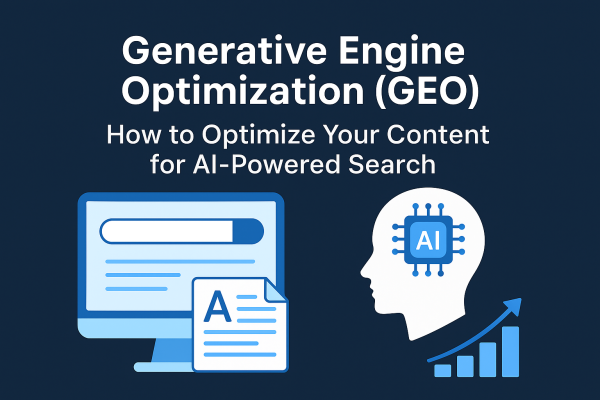Introduction
Search engines have shaped the internet for nearly 30 years. From the rise of Google in the late 1990s to the SEO boom of the 2010s, digital marketing has always been about matching content with queries. But in 2025, the rules have fundamentally changed.
The world’s most powerful information gatekeepers are no longer search engines—they are generative AI systems like ChatGPT, Gemini, Claude, and Perplexity AI. These “answer engines” don’t deliver lists of links; they deliver direct synthesized responses.
For businesses and content marketers, this transition means that Generative Engine Optimization (GEO) is not just an evolution of SEO—it’s an entirely new paradigm.
This article takes a deep dive into how GEO will reshape the future of search, disrupt content marketing, and redefine how brands build digital visibility.
1. From Search Engines to Answer Engines
Traditional Search (SEO Era)
-
Search engines crawl billions of web pages.
-
They rank them according to relevance, authority, and keyword usage.
-
Users choose from a list of “blue links.”
Generative AI Search (GEO Era)
-
AI engines synthesize knowledge from multiple sources.
-
They produce conversational, context-aware answers.
-
Links are secondary—often hidden behind expandable citations.
This shift moves user interaction from exploration (clicking multiple sites) to consumption (trusting the generated response).
Key consequence: In an AI-first world, only a handful of sources are referenced. That means visibility is winner-takes-all—and GEO decides the winners.
2. Why GEO is a Game-Changer for Content Marketing
a) Decline of Organic Traffic
-
Historically, SEO drove 50–70% of organic website visits.
-
In generative search, the AI may never send the user to your website—it answers directly.
-
Marketers will need to measure success differently: being cited rather than ranking.
b) Brand Visibility Moves Inside the Answer
-
A user might never visit your site, but they might see your brand name as the AI’s cited source.
-
GEO turns marketing into in-answer branding.
c) New Metrics of Success
-
Old metric: keyword rankings, impressions, clicks.
-
New metric: AI citations, visibility inside generated responses, trust scores from AI engines.
d) Content Becomes Infrastructure
-
Instead of click-bait blogs, marketers must create trustworthy, structured, and fact-rich content that AI can integrate.
-
Your content is not just for humans—it’s training material for AI.
3. User Behavior Shifts in the GEO Era
Instant Gratification
-
Users want direct, summarized answers.
-
The “10 blue links” era is dying.
Conversational Discovery
-
Instead of typing “best CRM tools,” users ask:
“What’s the best CRM for a small business under $500/month?”
-
GEO forces brands to create content that answers long-form, conversational, highly contextual queries.
Trust Consolidation
-
Users rely on fewer sources.
-
Authority becomes concentrated: a few “AI-favored” sites dominate global visibility.
4. Opportunities for Content Marketers
Despite the risks, GEO opens massive new opportunities:
-
Authority Positioning
-
If your content is optimized, your brand becomes part of the AI’s knowledge base.
-
Imagine your company being cited in thousands of AI responses daily.
-
-
Long-Tail Domination
-
AI search is highly conversational, which means long-tail queries matter more than ever.
-
Brands can win by answering specific, niche, contextual questions.
-
-
Reduced Competition for Early Adopters
-
Just as early SEO pioneers dominated search for years, the first wave of GEO adopters will dominate generative engines.
-
-
Better User Experience
-
Content designed for GEO is clearer, structured, and authoritative.
-
This benefits both AI indexing and human readers.
-
5. Strategic Shifts for GEO-First Content Marketing
a) Build “AI-Friendly” Content Architecture
-
Structured headings (H2, H3)
-
Clear Q&A formatting
-
Bullet points & tables
-
Fact-checkable claims with citations
b) Double Down on Authority Signals
-
Author bios, credentials, and transparent sourcing
-
Backlinks still matter, but trust signals are paramount
-
First-hand data, original research, case studies
c) Optimize for Multimodal AI
-
Generative engines like Gemini don’t just process text—they analyze images, charts, audio, and video.
-
Future GEO requires multimodal optimization: text + visuals + structured data.
d) GEO Content Lifecycle
-
Create → Rich, factual, multi-format content
-
Optimize → Structured, conversational, credible
-
Monitor → Track AI citations & mentions
-
Adapt → Update based on shifts in AI behavior
6. Risks & Challenges of GEO
-
Reduced Web Traffic
-
Even if you’re cited, traffic might not flow back to your site.
-
-
Opaque AI Algorithms
-
Unlike SEO tools, AI citation logic is not fully transparent.
-
-
Winner-Takes-All Dynamics
-
Only a few brands get mentioned; many will be invisible.
-
-
Dependence on AI Gatekeepers
-
Content marketers may be at the mercy of AI companies’ ranking systems.
-
7. Looking Ahead: 2025–2030 Predictions
-
GEO will replace SEO as the dominant marketing discipline by 2030.
-
AI Citation Monitoring Tools will emerge, just like SEO analytics tools in the 2000s.
-
Brand + Data Ownership will become critical—companies will want to control how their information is used by AI.
-
Regulation may emerge, forcing AI engines to cite fairly and transparently.
Conclusion
The shift from SEO to GEO is more than a technical evolution—it’s a paradigm shift in how knowledge is distributed online.
In the old world, visibility meant ranking on Google’s first page. In the new world, visibility means being embedded inside AI’s answers.
For content marketers, this is both a threat and an opportunity. Those who cling to traditional SEO will watch their organic traffic decline. Those who embrace GEO will become the authoritative voices that AI engines trust—and the brands that users see every day inside generated responses.
The future of content marketing belongs to those who adapt to Generative Engine Optimization.
